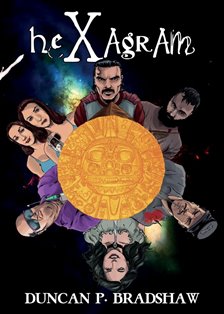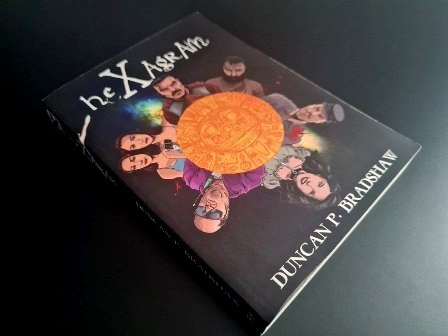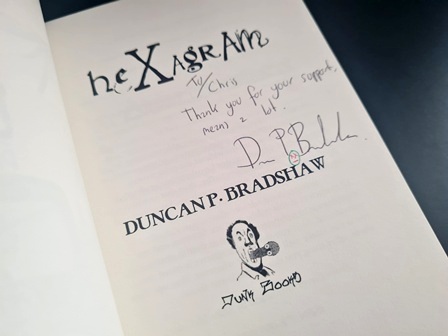
First published in July of 2016, British author Duncan P. Bradshaw’s latest offering is a curious and incredibly entertaining novel entitled ‘Hexagram’.
DLS Synopsis:
- March 1538 – Curzco, former Inca Empire.
In the darkened backstreets Spanish conquistador - Matias - had just finished with a local prostitute when he drunkenly stumbles into a masked stranger. Knowing he’s a tad worse for wear in his current condition, Matias apologies and backs off – only to find a second masked man lurking in the shadows behind him. He has the briefest of moments to realise this may be bad for him before the whole world goes black.
Matias comes to, tied to a stone block altar, and ready for sacrifice. His captors have one mission in mind – to raise Inti – their all-powerful God. To do so their law states that they should only collect from true Inca. But Poma - the Inti Priest - is impatient. He believes that every vessel of flesh and blood holds the dust. Every human has what they require within them. His harvest will continue – true Inca or not.
But when the Spanish conquistadors storm the basement of the ziggurat, the ancient ritual is cut short before the harvest can be concluded. With the Spanish soldiers now surrounding him and his loyal followers, the Inti Priest stands fast, swearing that the Inti will still take their revenge.
But such taunts fall on deaf ears. All around the basement the Inti succumb to the brute strength of the conquistadors. But for Rodrigo Quintaro the fight will be his last. With his final dying breaths he takes the Inti Priest’s sacred quipu – the ancient text detailing the terrifying Inca powers. And through the removal of the Inca quipu – the repercussions of that one action will echo through centuries to come.
- July 1716 – Pensacola, Florida.
When El Senor San Miguel’s ship is dashed upon the rocks after hitting an almighty storm, the surviving crew find themselves left marooned on this unknown land. And then when one of the men is discovered scalped, their predicament suddenly becomes a great deal more precarious. There are scavengers on this land.
But amongst the misery, suffering and danger of this blasted land, something of great power is waiting to be found. Nestled within ancient armour and forgotten for over a century; a folded piece of paper has now been discovered. An age-old script detailing something that’s inside all of creation. It tells of a residue which was formed from the birth of the world and from each star in the sky.
But what if such a thing could be true? What if God and the very dust of our creation was within all of us? By harvesting enough of this dust, one could invoke God to come to this realm. His almighty presence would be born in flesh and blood - yet still magnificent and apart from us.
It will prove to be a powerful secret which will haunt mankind for many centuries to come. The repercussions of the discovery will echo across many lifetimes. However the knowledge, and the terrible power it holds, will ultimately bring about the end of the world…
DLS Review:
This imaginatively epic story was originally planned to be a novella based on a simple concept: if we’re all made from the stars…what would happen if it was possible to extract this magical essence? The concept is one of those wonderfully original and ingeniously inspired ideas, that it just ends up having enough potential to expand into a full blown novel.
The tale is constructed from a series of short stories, all of which are based around a variety of individuals across five hundred odd years. Of course they all stumble across the ancient text at some point and find that they’re each drawn to the idea of harvesting this mysterious dust that’s apparently within us all. And so, through these time-staggered stories, we’re given a unique window into the recurring impact that this ancient Inca knowledge has on humanity.
Of course this was never going to end up like a quirky history lesson, or like something out of Tony Robinson’s ‘Time Team’. Yes, we’re given plenty of windows into history which are spread across the length of the book. But the consequences on each visit are far grimmer than your usual historical drama. Put it this way - what’s contained in this ancient text has enough power to influence the bearer to begin a campaign of harvesting a strange dust that’s within our bodies. Of course, in order to do so, people must be killed - their innards removed and then then mashed up into a sludgy paste.
So yeah, Bradshaw’s latest offering is a bit of a quirky and gory read. Laced with black comedy and an imaginatively meandering storyline – the novel has so much colour and creativity about it that it’s hard not to get completely sucked into the strange history he’s created.
One key ingredient to the whole thing is with the characters. To encapsulate the energy and vibrant pace of the novel they all have to be strong, bold, and instantly recognisable – with enough flesh in each character for the reader to properly latch on to. What we’ve seen with Bradshaw’s previous offerings has delivered this sort of characterisation in abundance. And what’s good to see here is that his latest novel’s no exception.
What you get is a rich tapestry of characters whose experiences as a result of gaining this ancient Inca knowledge, all intermingle and overlap. From the initial catalyst at the beginning of the novel, there’s a noticeable momentum behind the escalation of events which echoes across the five hundred odd years. Of course it’s helped further by a ‘countdown to the end of the world’ which Bradshaw discloses at the start of each new story. As such you know the end is coming. Each chapter and each story brings you closer to it. And the stories just seem to get wilder the nearer you get to that inevitable apocalyptical conclusion.
One aspect that works particularly well with the novel is how Bradshaw’s chosen to interweave his echoing Inca curse (for want of a better word) with real life events from our past. Starting off in 1538 you’ve got the ancient Inca ritual which is cut short and ultimately sets the ball rolling for the entire story. Jump forward some 180 odd years and you’ve got the story of a survivor from the Spanish Treasure Fleet of 1715. Then you’re launched forward to 1864 to the American Civil War, whereupon a confederate soldier takes up the reins of the tale. Following this the story leaps forward to 1888 and the time of the infamous serial killer - Jack the Ripper. Then we’re moved on to 1981 and a haunting parody of the Jonestown Massacre of 1978. However here instead of the Reverend Jim Jones we’re treated to an equally monstrous cult leader by the name of Jim Gimbal…of Gimbaltown (see what Bradshaw’s done there?!). Fast forward one last time and we’re finally at the present day, with the countdown clock letting us know we’ve now reached the final dice roll.
So what do you get from all these six different stories…these six different periods in time that are all connected because of the disturbed Inca ritual? Well, first and foremost you get something that feels fresh, original and wonderfully imagined. Trust me, there’s absolutely no time for the story to even hint at getting stagnant. Each jump forwards in time offers up a whole new backdrop, a whole new angle, and a whole new attitude. At each juncture it’s like a new lease of life has suddenly been injected into the storyline. The energy is topped up, the intrigue is reset, and the pacing is given a fresh restart.
Bradshaw concludes the novel by returning to those initial sparks of wonder we witnessed at the very start of the novel. In doing so he reels the entire storyline back in on itself with a well-executed and tightly plotted wrap-around story that bookends the condensed saga with nothing short of stylish elegance and literary charm.
There’s just so much to like about this novel. It’s exciting and energetic and feels refreshingly original from the very outset. As we’ve seen time and time again, Bradshaw always walks his very own path. There’s no one else out there writing anything remotely similar to the stuff he thinks up. Each offering is unique and colourful, with so much obvious enjoyment injected into the creation of the tales.
If Dostoyevsky is the Rembrandt of the literary world, then Bradshaw is surely the Andy Warhol.
The novel runs for a total of 305 pages.
© DLS Reviews









